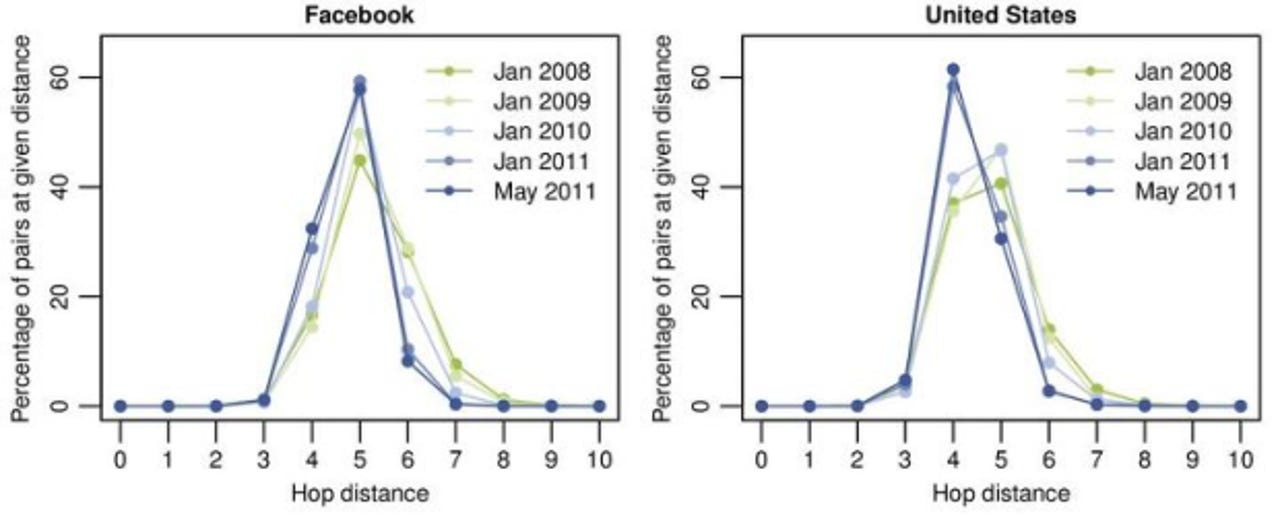Facebook users now separated by 4.74 degrees

Three months ago, I wrote about how Yahoo and Facebook are trying to figure out whether the "six degrees of separation" idea (everyone is on average approximately six steps away from any other person) is valid or not. The goal is to determine the social path length between two strangers by tapping into the world's largest social network and its 750 million active users (now it's over 800 million).
It turns out that Facebook and the University of Milan conducted a similar study earlier this year. At the time, Facebook had 721 million active users, with 69 billion friendships among them. Facebook's Data team has now revealed that any two people on the site are on average separated by just 4.74 intermediate connections, as of May 2011. A bit less surprisingly, it was also observed that while the entire world is only a few degrees away, a user's friends are most likely to be of a similar age and come from the same country.
The Laboratory for Web Algorithmics at the University of Milan developed state-of-the-art algorithms to help Facebook approximate the number of hops between all pairs of individuals on Facebook. Six degrees was found to overstate the number of links between typical pairs of users: while 99.6 percent of all pairs of users are connected by paths with five degrees (six hops), 92 percent are connected by only four degrees (five hops). When the analysis is limited to a single country, the world gets even smaller, and most pairs of people are only separated by three degrees (four hops).
It was also discovered that the degrees of separation between any two Facebook users has been shrinking over the past three years as the social network has grown, representing an ever larger fraction of the global population: the average distance in 2008 was 5.28 hops, while now it is 4.74.
Facebook has released two studies based on its findings: The Anatomy of the Facebook Social Graph (J. Ugander, B. Karrer, L. Backstrom, C. Marlow) and Four Degrees of Separation (L. Backstrom, P. Boldi, M. Rosa, J. Ugander, S. Vigna.). To date, these are the largest social network studies ever released.
"In these two works, we show how the Facebook social network is at once both global and local," a Facebook spokesperson said in a statement. "It connects people who are far apart, but also has the dense local structure we see in small communities. We show that, as Facebook has grown over the years, representing an ever larger fraction of the global population, it has become even more connected. In the years to come, we look forward to continuing to illuminate social trends and helping people understand how the world is becoming more connected."
In 1929, Hungarian author Frigyes Karinthy published a volume of short stories titled "Everything is Different." One such story was called "Chains" or "Chain-Links" (depending on the translation) and investigated many of the problems in the field we now call network theory. Karinthy's piece suggested that due to technological advances in communications and travel, the modern world was "shrinking" because growth in the density of friendship networks was offsetting the growth in physical distances between human beings.
As a result of this hypothesis, Karinthy's characters believed that any two individuals could be connected through at most five acquaintances. In the years to come, mathematicians, sociologists, and physicists questioned its validity.
In 1967, Harvard sociologist Stanley Milgram sent roughly 300 letters to randomly selected people in Omaha, Nebraska with the instruction to get the letter to a single "target" individual – a stockbroker in Boston. Milgram told them his name, address, and occupation, so that they could send the letter to someone they knew who they thought would be "closer" to the target than they. Just 64 letters reached the target, and Milgram found that people in the US seemed to be connected by approximately three friendship links on average, but he did not speculate on global linkages.
This, and similar other experiments conducted by Milgram were made popular an article titled "Small World Problem" published in the science journal Psychology Today. As for the actual "six degrees of separation" term, American playwright John Guare wrote a play in 1990 and later released a film in 1993 that popularized it.
Other researchers conducted several experiments to examine the average path length for social networks of people, mainly focused on the US. It is now generally accepted that there were potential flaws in these attempts because the conclusions were based on relatively small number of research samples.
It's important to note that while Milgram was motivated by the same question (how many individuals separate any two people), these numbers are not directly comparable; his subjects only had limited knowledge of the social network, while Facebook here has a nearly complete representation of the entire thing. The company's findings essentially describe the shortest possible routes that his subjects could have found. This is also why the Yahoo study is likely continuing: it's going to test a closer version to Milgram's original description of the problem.
See also:
